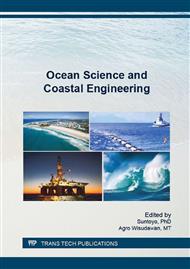[1]
Anonim, Maize. http: /id. wikipedia. org/wiki/Maize.
Google Scholar
[2]
Apriliyanti, T., The study of physiochemistry and sensory of purple sweet potato flour (Ipomoea batatas blackie) with variations of the drying process, Thesis, Faculty of Agriculture University of Sebelas Maret, Surakarta, (2012).
Google Scholar
[3]
Aslamyah, Environmental quality and Digestive Enzyme Activity of vannamei (Litopenaeus vannamei) at different concentrations of Probiotic Bacillus Sp., Bioremediation-Fish Scientice, Journal of Fisheries Sciences and Marine. 1(2) (2011) 161-174.
DOI: 10.20527/fs.v1i2.1186
Google Scholar
[4]
Central Bureau Of Statistics Of South Sulawesi, South Sulawesi in Numbers, (2014).
Google Scholar
[5]
Budiarti, T., Evaluation of organic matter accumulation, strained and tiger prawn production in intensive cultivation, Graduate Thesis, The Graduate Program of Bogor Agricultural University, (1998).
Google Scholar
[6]
Campbell, P.N. and D. Smith, Biochemistry illustrated, Churchill Livingstone, Edinburg-London-Melbourne and New York, (1982).
Google Scholar
[7]
FAO, Feed and feeding of fish and shrimp, A manual on the preparation and presentation of compound feeds for shrimp and fish aquaculture, (1987).
DOI: 10.1016/0044-8486(88)90284-0
Google Scholar
[8]
Marine and Fisheries Department of South Sulawesi, Annual report of the realization of development goals and Fisheries of South Sulawesi. Marine and Fisheries Department of South Sulawesi province, (2008).
DOI: 10.21776/ub.ecsofim.2017.004.02.02
Google Scholar
[9]
Gucic, M., E.C. Jacinto, R.C. Cerecedo, D.R. Marie & sL.R. Martínez-Córdov, Apparent (Decapoda: Penaeidae), cultivated at different salinities. Rev. Biol. Trop. 61(3) (2013) 1201-1213.
Google Scholar
[10]
Haliman, R.W. and A.S. Dian, Vannamei (Litopenaeus vannamei): cultivation and market Outlook of white shrimp disease resistant. The Diffuser Is Self-help, Jakarta, (2005).
Google Scholar
[11]
Haryati, E. Saade and Zainuddin, The formulation and application of feed for the parent and enlargement: application of artificial feed to increase the quality of the parent local tiger shrimp. Competitive Grants Research Research Report Appropriate National Priorities, (2009).
Google Scholar
[12]
Johnson LA, Corn: Production, Processing and atilitation. In Lorenzo KJ, Kulp K, editor. Handbook of Cereal Science and Technology. New York: Marcel Dekker Inc., (1991).
Google Scholar
[13]
Koshio, S, T. S. Teshima, A. Kanazawa and T. Watase, The effect of dietary protein content on growth, digestion efficiency and nitrogen excretion of juvenile kuruma prawns, Penaeus japonicus. Aquaculture. 113 (1993) 101-114.
DOI: 10.1016/0044-8486(93)90344-x
Google Scholar
[14]
Latif, I., Management of artificial feeding on shrimp intensively farmed at PT. Asindo Setiatama Bulukumba Regency, Report working practices, Aquaculture Courses, UNHAS FIKP, (2008).
Google Scholar
[15]
Monoarfa, W. D., Characterization and management of residual organic material on land farmed shrimp intensive basis, Dissertation Graduate School of Hasanuddin University, (2000).
Google Scholar
[16]
NRC, Nutrient requirements of warm water fishes and shellfishes, National Acad. Press, Washington., (1988).
Google Scholar
[17]
Shiau, S. Y., Utilization of carbohydrates in warm water fish – with reference to tilapia, Oreochromis niloticus X O. aureus. Aquaculture. 151 (1997) 79-96.
DOI: 10.1016/s0044-8486(96)01491-3
Google Scholar
[18]
Spanhof, L and H. Planktikov, Studies on carbohydrate digestion in rainbow trout. Aquaculture. 30 (1983) 95-108.
Google Scholar
[19]
Watanabe T., Fish nutrition and mariculture. JICA textbook, (1988).
Google Scholar
[20]
Yigit, M., S. Koshio, O. Aral, B. Karaaliand S. Karayucel, Ammonia nitrogen excretion rate – An index for evaluating protein quality of three feed fishes for the black sea turbot. The Israeli Journal of Aquaculture – Bamidgeh 55 (1) (2003) 69-76.
DOI: 10.46989/001c.20330
Google Scholar
[21]
Zainuddin, A bustang and Siti Aslamyah, The use of Probiotics on Artificial Feed for Tiger Shrimp Enlargement. Competitive Grants Research Report on National Priorities. Hasanuddin University. Makassar, (2009).
Google Scholar


